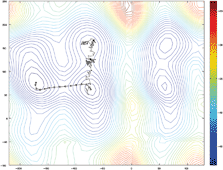Evolution of conformational changes in the dynamics of small biological molecules: a hybrid MD/RRK approach
Abstract
The dynamics of long timescale evolution of conformational changes in small biological molecules is described by a hybrid molecular dynamics/RRK algorithm. The approach employs classical trajectories for transitions between adjacent structures separated by a low barrier, and the classical statistical RRK approximation when the barrier involved is high. In determining the long-time dynamics from an initial structure to a final structure of interest, an algorithm is introduced for determining the most efficient pathways (sequence of the intermediate conformers). This method uses the Dijkstra algorithm for finding optimal paths on networks. Three applications of the method using an AMBER force field are presented: a detailed study of conformational transitions in a blocked valine


 Please wait while we load your content...
Please wait while we load your content...